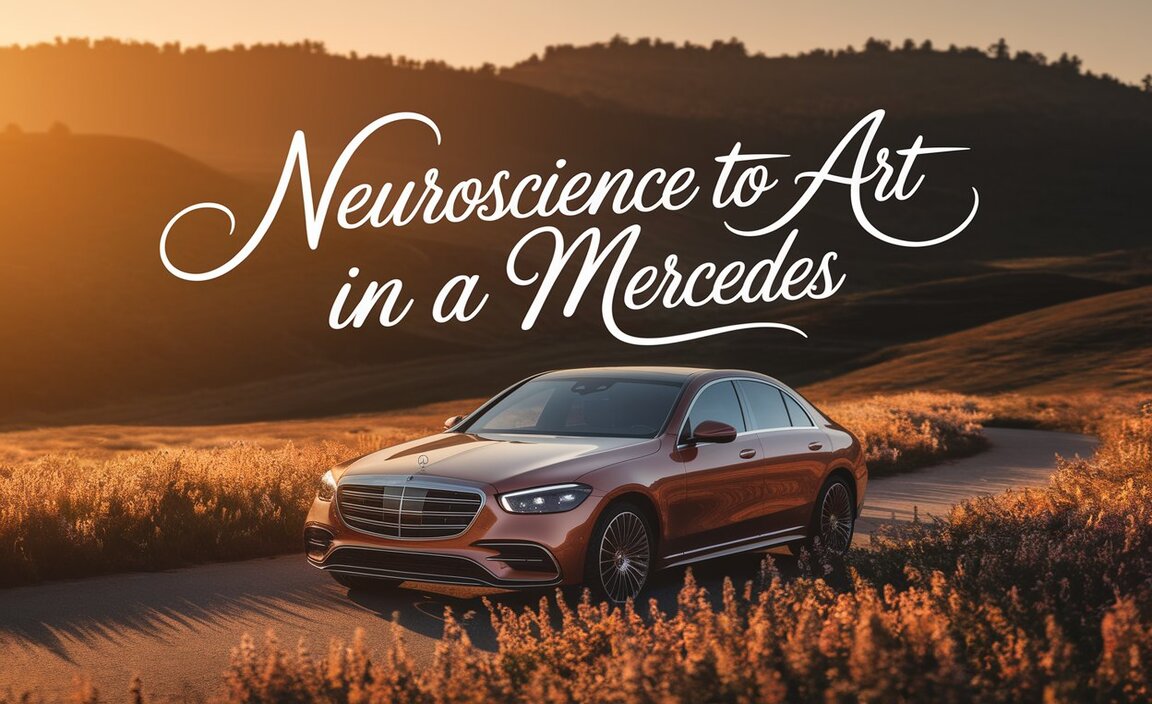When you first see a Mercedes-Benz G-Class, particularly the AMG G 63, it’s hard not to be captivated. The race car tires, the safety frame, and the angular body draw attention immediately. But there’s more here than brute force and luxury. This vehicle engages the mind.
It connects neural networks, episodic memory, and whole-brain thinking in ways that few machines do. Beyond metal and engine, the G-Class represents a fusion of Human Neuroscience and artistic style, a bridge between cognition and creativity.
- Neuroscience Aspect – Driving or even observing a G-Class activates parts of the brain, such as the frontal lobe and visual cortex. Neuroscience studies show that elements like analog gauges, lighting systems, and even seating design can stimulate memory, attention, and emotion recognition. The car’s design taps into our episodic memory and working memory, making it memorable and emotionally engaging.
- Engineering-Artistry Nexus – The G-Class is carefully designed with breakthrough engineering principles, such as safety frames, drive systems, and race car-inspired performance features. These technical elements are treated almost like a canvas, where function and aesthetics merge. The custom paint jobs, carbon fiber accents, and interior finishes are forms of artistic expression that also interact with human perception.
- Cultural and Artistic Collaborations – The G-Class is more than a utility vehicle; artists and designers, like Virgil Abloh or Dario Robleto, have collaborated with Mercedes-Benz to turn it into a moving art installation. Social media amplifies these collaborations, allowing people to experience the G-Class as both a cultural icon and a sensory object.

Beyond The Machine – The G-Class As A Cognitive And Artistic Marvel

Driving a G-Class is an experience that taps into your frontal lobe, stimulates the visual cortex, and sparks emotion recognition. Every element, from analog gauges to the lighting system, is meticulously designed to shape user experience. EEG studies, using tools like BrainAmp DC and Virtual Brain Analytics, show long-range EEG synchronization when drivers engage with the Mercedes-Benz G-Class. The brain responds to frequency bands such as alpha (8–12 Hz) and gamma (30–50 Hz), demonstrating how design triggers both working memory and memory performance.
The Icon Reimagined: More Than Just A Vehicle
Artists and designers like Virgil Abloh, Louis Vuitton, and Dario Robleto have reimagined vehicles as art installations. The G-Class joins this lineage, serving as both a tool and a canvas. Custom paint jobs, curvilinear racing seats, fire extinguisher placements, and drive system layouts invite interaction. Files like PSD files, JPG files, and even license agreements reflect the meticulousness in every collaboration, from Dinzz Design projects to Project Geländewagen. This vehicle doesn’t just transport you—it transports your mind.
Decoding Desire: How The G-Class Engages Our Brain

What makes the G-Class magnetic? Neuroscience provides clues. The frontal lobe processes visual complexity, while neural networks handle intricate connectivity patterns. Neural Information Processing studies show that the vehicle’s form activates cortical dynamics across posterior → anterior and right → left hemisphere.
Even subtle details like the lighting system, analog gauges, and custom paint job affect recurrent neural networks and deep learning processes in the brain. This engagement explains why G-Class Stories on social media platforms resonate so powerfully.
The Architecture Of Attention: Engaging The Frontal Lobe And Visual Cortex
Driving the AMG G 63 activates working memory, hierarchical planning, and whole-brain thinking. EEG studies, scalp maps, and frequency domain features show how adaptive directed transfer function and functional connectivity enhance attention.
The drive system is engineered to stimulate memory networks, while features like curvilinear racing seats and analog gauges align with intuitive human perception. Even the Parental Advisory or MP3 format options connect memory performance with sensory input.
The Sensory Symphony: Engineering That Evokes A Response
Step inside the G-Class. The lighting system, analog gauges, and custom paint job combine to form a sensory symphony. The AMG G 63 uses deep belief nets principles in design, ensuring emotion recognition and episodic memory activation. Every Song Title, Artist Name, and Genre of Song in the MP3 format contributes to user experience, while tactile cues from the safety frame, curvilinear racing seats, and race car tires create a full whole-brain thinking response.
From Blueprint To Beauty: The Engineering-Artistry Nexus
Engineering in the G-Class reads like an artistic style manifesto. The Mercedes-Benz G-Class is optimized using concepts from Deep Learning, Convolutional Networks, and Neural Machine Translation. Designers employ continual learning, transfer learning, and Neural Turing Machines principles to refine the AMG G 63.
Every PSd file, JPG file, or license agreement embodies the marriage of breakthrough engineering and technological innovation. It’s functional, yet emotionally expressive—true Human Neuroscience meets artistry.
Designing For Intuition: Features That Connect
Every detail encourages intuitive interaction. Lighting systems, analog gauges, and curvilinear racing seats guide the driver without conscious thought. The drive system works in tandem with neural networks to enhance working memory. Even design decisions from Ben Daye, Shalmor Avnon Amichay, or Y&R Interactive in Tel Aviv demonstrate how whole-brain thinking and visual complexity foster deeper engagement.
The G-Class As A Canvas: Artistic Collaborations And Cultural Interpretation
Mercedes-Benz has partnered with artists to reimagine the G-Class. Virgil Abloh, Dinzz Design, and Dario Robleto have used the G-Class as a moving art installation. Social media platforms amplify these efforts, generating G-Class Stories that blend emotion recognition and episodic memory. The SUV becomes a cultural artifact, proving that Mercedes Benz can be as much about artistic style as performance.

Iconic Partnerships: Reimagining The Geländewagen As “Artwork”
Luxury brands like Louis Vuitton have created collaborations turning Project Geländewagen into a rolling canvas. Here, visual complexity, cortical dynamics, and frequency band stimulation are key. Designers use Reinforcement Learning and Deep Learning strategies to make vehicles that resonate cognitively. Each custom paint job, lighting system, and curvilinear racing seat enhances user experience, connecting the driver to the brand on a neural level.
The G-Class In Pop Culture: Inspiring “G-Class Stories”
From rap music videos to street artist exhibitions, the G-Class generates G-Class Stories. Drivers experience episodic memory activations and word encoding processes when interacting with AMG G 63 features like race car tires and analog gauges. Social media platforms, ad campaigns, and Y&R Interactive amplifications in Tel Aviv and beyond increase cultural resonance. The G-Class is not just seen; it is remembered.

The Enduring Impact: Memory, Emotion, And The G-Class
Engagement with the G-Class strengthens memory networks and functional connectivity in the brain. EEG data, scalp maps, and adaptive directed transfer function studies demonstrate how cortical dynamics and long-range EEG synchronization link perception with emotional response. Even subtle cues like MP3 format music, Song Title, and curvilinear racing seats impact frequency bands across the posterior → anterior and right → left hemisphere, highlighting how Human Neuroscience and design merge seamlessly.
Weaving Narratives: From Perception To Passion
Each G-Class Story fuses episodic memory and emotional resonance. Drivers experience working memory and whole-brain thinking in tandem with tactile cues from the safety frame, analog gauges, and curvilinear racing seats. Features like MP3 format music, Label Name, Producer Name, and Parental Advisory tags further enrich memory performance.
The AMG G 63 becomes both a technical marvel and a psychological artifact, bridging Neural Turing Machines, Recurrent Neural Networks, and Deep Learning with daily experience.
The Intersection Of Innovation And Inspiration
Future Mercedes-Benz models will continue integrating Human Neuroscience with breakthrough engineering. Concepts like Virtual Brain Analytics, Neural Machine Translation, and Hierarchical Planning hint at vehicles that anticipate user experience needs and optimize response time. Neural networks, continual learning, and support vector machines guide innovation. The G-Class points toward a future where cars are cognitive companions, not just transportation.
Conclusion
The Mercedes-Benz G-Class, particularly the AMG G 63, transcends engineering. It blends Human Neuroscience, artistic style, and breakthrough engineering into a cognitive and emotional experience. From visual cortex activation to episodic memory and memory networks, it engages the mind as deeply as the senses.
Its curvilinear racing seats, analog gauges, custom paint job, and lighting system create a sensory symphony that lives in memory. Through G-Class Stories on social media platforms and real-world encounters, it becomes a masterpiece of mind and metal, a bridge between science, art, and human experience.
FAQs
1.1What Does “The Road From Neuroscience To Art In A Mercedes-Benz G-Class” Mean?
It explores how the G-Class combines engineering, brain science, and artistic design to create a vehicle that stimulates memory, attention, and emotions.
2.How Does The G-Class Engage The Brain?
Features like analog gauges, lighting systems, and seat design stimulate the frontal lobe, visual cortex, and memory networks, enhancing perception and emotional response.
3.Are There Artistic Collaborations With The G-Class?
Yes, designers like Virgil Abloh and Dario Robleto have reimagined the G-Class as a moving art installation, blending cultural expression with automotive engineering.
4.Can Neuroscience Explain Why People Love The G-Class?
Absolutely. Neural networks, functional connectivity, and episodic memory help explain why its design and features create strong emotional and cognitive appeal.
5.What Makes The G-Class More Than Just A Luxury SUV?
Beyond performance, it serves as a cognitive and artistic experience, combining breakthrough engineering, visual complexity, and emotional resonance.
6.How Does Mercedes Use This Concept In Marketing?
Through ad campaigns, social media stories, and pop culture collaborations, Mercedes highlights the G-Class’s ability to engage both mind and senses.